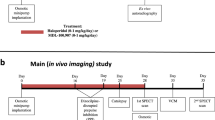Abstract
The [14C]-2-deoxyglucose method was used to map the in vivo metabolic response of glucose to savoxepine, a novel tetracyclic cyano-dibenzoxepino-azepine. Savoxepine is reported to have higher affinity for dopamine (DA) receptors in the hippocampus than in the striatum and hence should have dose-dependent, anatomically selective actions. Two doses of savoxepine (0.05 mg/kg and 0.5 mg/kg) were compared with haloperidol (1 mg/kg) to test the hypothesis that low doses of savoxepine would display a selective action on limbic brain areas. Results failed to show that low dose savoxepine selectively modifies glucose utilization in the limbic system as previous biochemical studies suggested. In fact, low doses of the drug displayed a potent activity quite similar to haloperidol in effect and localization. The low dose did not produce significantly altered glucose metabolism in the nucleus accumbens or in the lateral habenular nucleus as observed with most other neuroleptics, suggesting a lack of antipsychotic action at this dose. Our findings demonstrate the difficulty of designing a neuroleptic with a preferential blockade of limbic DA receptors and point to the need for functional assessment of regional receptor binding differences.
Similar content being viewed by others
References
Bischoff S, Christen P, Vassout A (1988) Blockade of hippocampal dopamine (DA) receptors: A tool for antipsychotics with low extrapyramidal side effects. Prog Neuropsychopharmacol Biol Psychiatry 12:455–467
Carlsson A, Lindquist L (1963) Effect of chlorpromazine or haloperidol on formation of 3-methoxytyramine and normetanephrine in mouse brain. Acta Pharmacol Toxicol 20:140–145
Cascella NG, Tarazi FI, Shirakawa O, Tamminga CA (1991) Typical vs atypical neuroleptics: Differences in regional cerebral glucose utilization in rats. Soc Neurosci Abstr Vol. 17
McCulloch J, Savaki HE, Sokoloff L (1982) Distribution of effects of haloperidol on energy metabolism in the rat brain. Brain Res 243:81–90
Palacios JM, Wiederhold KH (1985) Dopamine D2 receptor agents, but not dopamine D1, modify brain glucose metabolism. Brain Res, 327:390–394
Palacios JM, Niehoff DL, Kuhar MJ (1981) [3H]spiperone binding sites in brain: autoradiographic localization of multiple receptors. Brain Res 213:277–289
Skagerberg G, Lindvall O, Bjorklund A (1984) Origin, course and termination of the mesohabenular dopamine pathway in the rat. Brain Res, 307:99–108
Sokoloff L, Reivich M, Kennedy C, Des Rosiers MH, Patlak CS, Pettigrew KD, Sakurada O, Shinohara M (1977) The [14C]deoxyglucose method for the measurement of local cerebral glucose utilization: theory, procedure, and normal values in the conscious and anesthetized albino rat. J Neurochem 28:897–916
Tarazi FI, Shirakawa O, Tamminga CA (1993) Low dose raclopride spares the extrapyramidal system in rat brain from metabolic effects. Eur J Pharmacol 232:71–77
Wetzel H, Wiedemann K, Holbsoer F, Benkert O (1991) Savoxepine: invalidation of an “atypical” neuroleptic response pattern predicted by animal models in an open clinical trial with schizophrenic patients. Psychopharmacology 103:280–283
Author information
Authors and Affiliations
Rights and permissions
About this article
Cite this article
Cascella, N.G., Tarazi, F.I., Shirakawa, O. et al. Savoxepine fails to selectively influence glucose metabolism in the rat limbic system. Psychopharmacology 114, 275–280 (1994). https://doi.org/10.1007/BF02244849
Received:
Accepted:
Issue Date:
DOI: https://doi.org/10.1007/BF02244849




